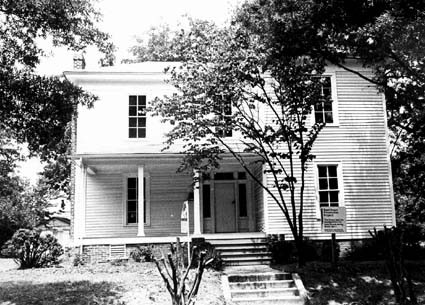Dowd House
Introduction
Text-to-speech Audio
Images
Dowd House Exterior

Dowd House Exterior 1978

Dowd House Historical Postcard, Undated


Soldiers in training at Camp Greene, Charlotte NC, c. 1917 (courtesy North Carolina Collection, Wilson Library, UNC-Chapel Hill).

Backstory and Context
Text-to-speech Audio
In 1878 James Dowd signed a deal with his brother, Clement Dowd to purchase approximately 250 acres of land to the west of downtown Charlotte. The son of Confederate general Willis Dowd, James Dowd was a Native North Carolina resident and had served in the 45th Regiment of the Civil War. After the completion of the war he moved with his wife, Henrietta Rives, to Mecklenburg County, and purchased the property to build a home. The James Dowd house was completed in 1879, and within the twenty years prior to his death would become one of the most prominent farmers in the country. His status in Charlotte went further then wealthy farmer, as he was also an active participant in Charlotte politics and religious activities. His funeral was held at the Tryon St. Baptist Church, where he had served as a deacon.
Dowd’s wife, Henrietta, gave birth to ten children during their marriage. Several of these children would become notable Charlotte figures during their lifetimes. William Carrey Dowd purchased The Charlotte News in 1895, and Willis Frank Dowd, who started the Charlotte Pipe and Foundry Co. in 1900.
Over the next several decades the home would transfer ownership several times. In 1917, the Dowd House became the commandant's quarters for Camp Greene, an important US Army training camp. The property was selected due to its high elevation, which provided a panoramic view of the camp. Additions were built onto the original home to allow for more offices on site.
As the country geared up after its entry into the First World War, Camp Greene became a central training facility for the US Army; both the 3rd and 4th Infantry Divisions were organized at the facility. Camp Greene played a crucial role in the 20th-century growth of Charlotte. In 1917, the town's population was roughly the same as that of Camp Greene itself--approximately 40,000. Over the course of the war, Camp Greene would house more then 60,000 soldiers on its grounds.
Today the Dowd House is open to visitors who can view the home’s historical significance along with relevant artifacts, papers, and furniture. While the home’s structure is significantly different from the original building constructed by Dowd, many artifacts pertaining to that original home still exist. Additionally, there is a great deal of information on the home’s involvement in the war, the solider’s quartered on the property, and it’s impact on North Carolina’s involvement in the armed services.
Sources
"Historic Camp Greene--About," http://www.historiccampgreene.com/about, accessed on June 15, 2019.
Herbert White, "Camp Greene," https://www.ourstate.com/camp-greene/, accessed on June 15, 2019.
